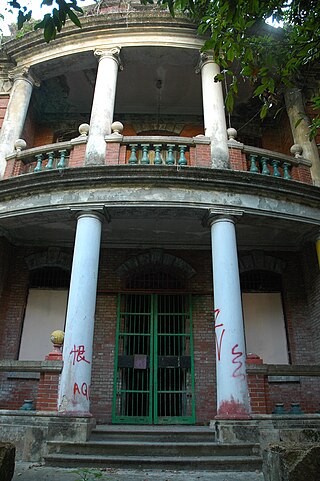
Most of the walled villages of Hong Kong are located in the New Territories.

Sheung Wan is an area in Hong Kong, located in the north-west of Hong Kong Island, between Central and Sai Ying Pun. Administratively, it is part of the Central and Western District. The name can be variously interpreted as Upper District, or Gateway District.

St. Joseph's Home for the Aged is located at No. 35 Clear Water Bay Road, Ngau Chi Wan, Wong Tai Sin, New Kowloon, Hong Kong. The site spans 230,000 square feet (21,000 m2).

The Victoria Barracks were a barracks in the Admiralty area of Central on Hong Kong Island, Hong Kong. The barracks were constructed between the 1840s and 1874, and situated within the area bounded by Cotton Tree Drive, Kennedy Road and Queensway. Together with Murray Barracks, Wellington Barracks and Admiralty Dock, the barracks formed a British military zone in Central. The barracks was named for Queen Victoria, monarch at the time of construction.

Queen's Pier, named after Queen Victoria, was a public pier in front of City Hall in Edinburgh Place, Central, Hong Kong. For three generations it served not only as a public pier in day-to-day use but also as a major ceremonial arrival and departure point. The pier witnessed the official arrival in Hong Kong of all of Hong Kong's governors since 1925; Elizabeth II landed there in 1975, as did the Prince and Princess of Wales in 1989.

Kennedy Road is a road in the Mid-Levels on Hong Kong Island, Hong Kong. It is named after Arthur Kennedy, the seventh governor of Hong Kong.

Victoria Prison, was the first and longest-running prison to date in Hong Kong. It is located on Old Bailey Street in Central, Hong Kong Island. Named in honour of Queen Victoria, it was originally known as Victoria Gaol and was renamed into Victoria Prison in 1899. Victoria Prison has been redeveloped into a cultural and shopping destination generally called Tai Kwun (大館). Tai Kwun is composed of three declared monuments: the former Central Police Station, former Central Magistracy and Victoria Prison.

The Antiquities and Monuments Ordinance, in Hong Kong Law, was enacted in 1976 to preserve the objects of historical, archaeological and palaeontological interest and for matters ancillary thereto or connected therewith. It is administered by the Antiquities Authority, with the executive support of the Antiquities and Monuments Office under the Development Bureau, since 2007.
Hong Kong cultural policy refers to the development and preservation of Hong Kong's arts and cultural heritage. Globally, Hong Kong is perhaps best known for its role as an international financial centre and shopping hub, and not for its artistic and cultural offerings. The popular stereotype of the city holds that its residents are far too focused on getting and spending to concern themselves with the ephemeral affairs of art and culture.

The Antiquities Advisory Board (AAB) is a statutory body of the Hong Kong Special Administrative Region with the responsibility of advising the Antiquities Authority on any matters relating to antiquities and monuments. The AAB was established in 1976 along with the Antiquities and Monuments Office (AMO) when the Antiquities and Monuments Ordinance (Cap. 53) was enacted, and comprises members appointed by the Chief Executive. The corresponding governmental ministry is the Development Bureau, and executive support for the AAB is provided by the AMO which is under the Development Bureau.

Nam Koo Terrace is a Grade I Historic Building located at No. 55 Ship Street, Wan Chai, Hong Kong, popularly known as "The Wan Chai Haunted House". The building is currently owned by Hopewell Holdings, a large property development company based in Hong Kong.

This article details the history and status of heritage conservation in Hong Kong, as well as the role of various stakeholders.

The Jamia Mosque is a mosque in Mid-Levels, Hong Kong. The mosque is the oldest mosque in Hong Kong. The neighbouring streets Mosque Street and Mosque Junction are named after this mosque. Mufti Abdul Zaman is the main Imam of this Mosque and he leads prayers and taraweeh in the month of Ramadan.

Ho Tung Gardens, also known by its Cantonese name 'Hiu Kok Yuen', was a villa on the Peak, Hong Kong. It was built by Robert Hotung and his wife Clara in 1927. They referred to it as "The Falls", but it later became known as Ho Tung Gardens.

Sham Chung is a Hakka village and an area of Neolithic settlement in Hong Kong. It is located in the south of Tolo Channel, beside Three Fathoms Cove on the Sai Kung Peninsula. Administratively, it is part of Tai Po District.

The Lung Tsun Stone Bridge was a bridge in British Hong Kong which was buried during the construction of Kai Tak Airport and which connected the Kowloon Walled City to a pier leading into Kowloon Bay.

The State Theatre is a former cinema in Hong Kong. It is located in the North Point area along King's Road. Concerns were raised in 2015 that it may be demolished in the near future. The building was listed as a Grade I historic building in March 2017.

Woh Chai Shan, a.k.a. Shek Kip Mei Hill (石硤尾山), Mission Hill or Bishop Hill (主教山), is a hill in Shek Kip Mei, New Kowloon, Hong Kong. It is approximately 86 metres tall.


















